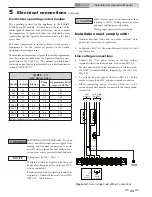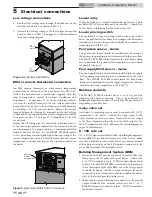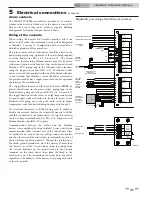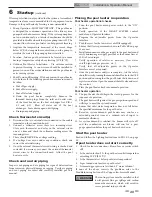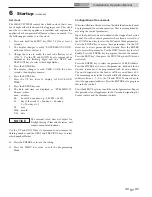
36
3
Gas connections
SUPPLY
INLET
PRESSURE
TAP
INLET
GAS
VALVE
CONTROL
KNOB
OUTLET
Installation & Operation Manual
Figure 3-3_
Measuring Gas Supply Pressure at
Combination Gas Valve
13. Remove the manometer and related fitting from the “inlet”
side of the gas valve, replace 1/8" hex plug in gas valve and
tighten.
14. Turn on gas supply at the manual valve, turn on L.P. gas at
the tank if required.
15. Turn the power switch to the “ON” position.
16. Turn the gas valve knob to the “ON” position.
17. Set the electronic temperature control or thermostat to call
for heat.
Combination gas valve/regulators equipped with integral vent
limiters are not required to have vent or relief lines piped to
the outdoors. The termination of the vent limited opening on
the combination gas valve/regulator complies with the safety
code requirements of CSD-1, CF-190(a) as shipped from the
appliance manufacturer without the installation of additional
vent lines.
Checking gas supply pressure
Use the following procedure to check gas supply pressure.
1. Turn the main power switch to the “OFF” position.
2. Turn gas valve knobs to the “OFF” position.
3. Shut off gas supply at the field-installed manual gas cock in
the gas piping to the unit. If fuel supply is L.P. gas, shut off
gas supply at the tank.
4. Remove the 1/8" hex plug, located on the “inlet” side of the
gas valve. You may also use a tapping on the field-installed
main manual gas cock or gas piping. Install a fitting in the
inlet pressure tapping suitable to connect to a manometer
or magnehelic gauge. Range of scale should be 14" w.c. or
greater to check inlet pressure.
5. Turn on gas supply at the manual gas cock, turn on L.P. gas
at the tank if required.
6. Turn the power switch to the “ON” position.
7. Turn the gas valve knobs to the “ON” position. Set the
electronic temperature control or thermostat to call for
heat.
8. Observe the gas supply pressure as all burners are firing.
Ensure that inlet pressure is within the specified range.
See Connecting To Gas Supply, page 34 for minimum and
maximum gas supply pressures.
9. If gas pressure is out of range, contact gas utility, gas
supplier, qualified installer or service agency to determine
necessary steps to provide proper gas pressure to the
control.
10. If gas supply pressure is within normal range, turn the
power switch to the “OFF” position.
11. Turn gas valve knobs to the “OFF” position.
12. Shut off gas supply at the manual gas cock in the gas piping
to the unit. If fuel supply is L.P. gas, shut off gas supply at
the tank.
⚠
WARNING
After completing any testing on the gas
system, leak test all gas connections. Apply
a soap/water solution to all gas connections
while main burners are operating. Bubbles
forming indicate a leak. Repair all leaks at
once. Do not operate this unit with a leak in
the gas train, valves or related piping.
Check burner performance by cycling the system while you
observe burner response. Burners should ignite promptly.
Flame pattern should be stable, see Burner Flames in the
Copper-fin
2
Service Manual. Turn system off and allow burners
to cool, then cycle burners again to ensure proper ignition and
flame characteristics.
TABLE - 3D
Capacity of Schedule 40 Metallic Pipe in Cubic Feet of Natural Gas Per Hour
(based on .60 specific gravity, 0.30" w.c. pressure drop)
Pipe
Size
(Inches)
Length of Pipe in Straight Feet
10
20
30
40
50
60
70
80
90
100
125
150
175
200
1/2
131
90
72
62
55
N/A
N/A
N/A
N/A
N/A
N/A
N/A
N/A
N/A
3/4
273
188
151
129
114
104
95
89
83
79
70
63
58
N/A
1
514
353
284
243
215
195
179
167
157
148
131
119
109
102
1 1/4
1,060
726
583
499
442
400
368
343
322
304
269
244
224
209
1 1/2
1,580
1,090
873
747
662
600
552
514
482
455
403
366
336
313
2
3,050
2,090
1,680
1,440
1,280
1,160
1,060
989
928
877
777
704
648
602
2 1/2
4,860
3,340
2,680
2,290
2,030
1,840
1,690
1,580
1,480
1,400
1,240
1,120
1,030
960
3
8,580
5,900
4,740
4,050
3,590
3,260
3,000
2,790
2,610
2,470
2,190
1,980
1,820
1,700
4
17,500 12,000
9,660
8,270
7,330
6,640
6,110
5,680
5,330
5,040
4,460
4,050
3,720
3,460
























